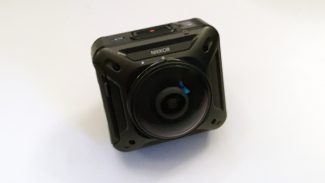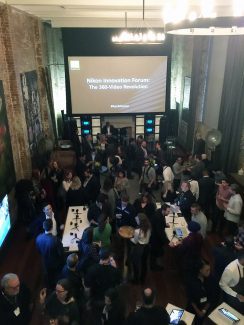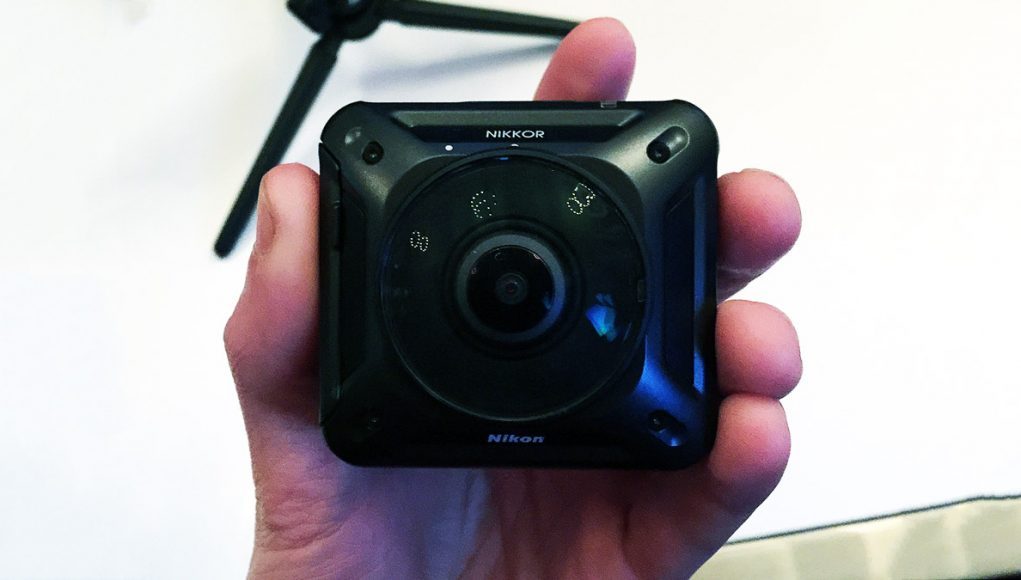Nikon’s foray into 360° video continued at the ‘Nikon Innovation Forum: The 360° Video Revolution’ event in NYC last week. There the company’s recently released KeyMission 360 action camera was the centerpiece among non-360° action cameras of the same series. In addition to the camera displays and examples of footage shot on Nikon’s KeyMission series, the event featured a 360° video-focused panel of accomplished industry folk and a brief address by Nikon’s President and CEO, Toru Iwaoka.
Road to VR’s Scott Hayden covered the KeyMission 360 back in January, concluding that, while the camera features robust resistance to elemental damage, Nikon hadn’t yet positioned the device specifically for capturing content to be viewed through a VR headset. Hayden commented that, Nikon hasn’t “said anything specifically about virtual reality in their promo material—and they have never uttered the phrase ‘VR camera’…”
 That changed ever so slightly at the event, with Nikon showing the camera alongside a Gear VR headset running sample footage. With the camera’s 360 footage easily uploaded to YouTube and viewed via YouTube VR on Daydream or Cardboard devices the door is indeed open for such use, and it seems Nikon is moving in that direction, especially given the composition of the panel presented at the event.
That changed ever so slightly at the event, with Nikon showing the camera alongside a Gear VR headset running sample footage. With the camera’s 360 footage easily uploaded to YouTube and viewed via YouTube VR on Daydream or Cardboard devices the door is indeed open for such use, and it seems Nikon is moving in that direction, especially given the composition of the panel presented at the event.
 Since my colleague has admirably covered the camera itself, and since I did not have any meaningful, app-inclusive hands-on time with the device at the event, and lastly, since Nikon continued merely to associate its 360° camera with VR, I will devote the remainder of this piece to the panel and impressions.
Since my colleague has admirably covered the camera itself, and since I did not have any meaningful, app-inclusive hands-on time with the device at the event, and lastly, since Nikon continued merely to associate its 360° camera with VR, I will devote the remainder of this piece to the panel and impressions.
First, the panelists—all of which have had their hand in significant 360 initiatives—and their swaggering LinkedIn profiles:
• Jessica Lauretti is Head of RYOT Studio, which was acquired in April by the Huffington Post.
• Matt Zymet is Executive Director, Digital Media, for National Geographic Channel.
• Heather Raikes is Creative Director at 8ninths.
• Rebecca Howard is SVP of Emerging Platforms and Partnerships at Discovery Communications (the company behind the likes of Discovery Channel, Discovery VR, Animal Planet, TLC, and many more).
• Michael Hopper is Senior Producer for Vice News.
It was largely a softball affair. Low-hanging fruits were plucked: “Shooting 360-video and stereoscopic VR posed challenges that producers didn’t conceive of prior to encountering them” captures the general tenor and content of panelists’ answers to one question.
 Hopper, in what he might call ‘the Vice style,’ regaled us with the story of a Vice crew sent to an Indonesian island blind to the illegalities of psilocybin mushrooms, and wouldn’t you know it, the Vice crew ate some mushrooms and, in its confused or perhaps astonishingly and primordially clear-headed state, deigned to filmed (with their cameras) island monkeys and bits of nature. (The lesson being that Vice is pretty cool).
Hopper, in what he might call ‘the Vice style,’ regaled us with the story of a Vice crew sent to an Indonesian island blind to the illegalities of psilocybin mushrooms, and wouldn’t you know it, the Vice crew ate some mushrooms and, in its confused or perhaps astonishingly and primordially clear-headed state, deigned to filmed (with their cameras) island monkeys and bits of nature. (The lesson being that Vice is pretty cool).
More seriously, the predictions and statements of belief squeezed out the panelists were that: “interactivity and mixed reality is… where is this is all headed” and Elon Musk is right about our matrix-reality (Lauretti); per Zuckerberg, “this is the next major computing software,” “computing is becoming three-dimensional; we will shed the 2-D rectangle” (Raikes); the wealthy “will have entire rooms dedicated to room-scale VR” and location-based and multisensory VR experiences will flourish (Zymet); things will really change once 360° cameras come standard on smartphones and more people can affordably view high-quality VR on high-quality rigs (Hopper).
Additionally, we did learn that 8ninths is finishing post-production on a 360° shoot of an Everest climb that’ll come out via Sports Illustrated next year. Raikes described the experience of ascending the mountain as “authentic, real, kind of slice-of-life.”
Finally, a wealth of advice and maxims, some of it likely actionable and genuinely useful, was handed out:
• If you’re filming in 360°, ensure that your rig is closer than you think it ought to be to your primary subject(s)—think 12ft or less.
• Carefully curate spaces and plan shoots for unscripted moments.
• Ensure that your talent for scripted programs is someone with whom people will want to spend time. Now do the same for your unscripted programming.
• Cut less; give the viewer time to survey each new scene.
• The viewer needs to perceive the scene under consideration as being “authentic” and “believable.”
• It is okay to fail, in life and VR.
• Post-production takes time.
• Content is the primary driver of viewer engagement.
• Creators need to be more game-designer than director.
In sum, the event was an opportunity for Nikon to put five professionals working in the VR, AR and 360° video spheres in a room with its products and for guests to mingle and hear from said professionals. As one would expect, the panelists’ prognosticating, advising and reminiscing were sometimes genuinely interesting and potentially practicable; other times they were standard fare.







